Chapter 24 Developing a Communications Express Architecture
This chapter contains Communications Express basic deployment architectures. Depending on the features you want to implement in your deployment, you will need to install different sets of hosts and other networking infrastructure.
This chapter contains the following sections:
Basic Communications Express Architecture
This basic Communications Express architecture provides Calendar, Address Book, and Mail modules in a web container on a single host. Messenger Express is the standalone web interface mail application that uses the HTTP service of the Messaging Server. Messenger Express is deployed on the same system as the Calendar and Address Book modules.
To provide this basic functionality, you need to install the following components:
-
Directory Server
-
Access Manager (If you are using Sun Java System LDAP Schema Version 2)
-
Calendar Server
-
Messaging Server
-
Web Server or Application Server (for the web container)
In this example:
-
You install the complete set of Messaging Server packages on the host that Communications Express is running on.
-
The AddressBook server of Communications Express is configured to store its data in the LDAP directory infrastructure.
-
SSL has not been configured.
Figure 24–1 shows the basic Communications Express architecture.
Figure 24–1 Basic Communications Express Architecture

The following table explains the protocols and port numbers used by this architecture.
Table 24–1 Protocols And Ports Used by Basic Communications Express Deployment Architecture|
Protocol |
Port |
Used By |
|---|---|---|
|
SMTP |
25 |
Messaging Server MTA component to communicate with other systems, and Calendar Server (csenpd) components for email notifications |
|
HTTP |
80 |
Internet users to communicate with Communications Express front-end, and Communications Express to communicate with Messaging Server |
|
HTTP |
81 |
Calendar Express on Communications Express to communicate with Calendar Server |
|
MSHTTP |
82 |
Internet users to communicate with Messenger Express |
|
LDAP |
389 |
Messaging Server and Calendar Server to communicate with LDAP directory |
Communications Express on Remote Host Architecture
Figure 24–2 shows a Communications Express architecture where both intranet and Internet users log on to Communications Express on the front-end host, which accesses the back-end host on the user's behalf. You can enable SSO on the front-end host such that Communications Express validates the session in Access Manager.
You install the front-end host with the following components:
-
Messaging Server (Webmail Server)
-
Web container
-
(Optional) Access Manager SDK
-
Communications Express
You install the back-end with the following components:
-
Directory Server
-
Messaging Server (Mail Store)
-
Calendar Server
-
(Optional) Web Container and Access Manager
Figure 24–2 shows the Communications Express on remote host architecture.
Figure 24–2 Communications Express on Remote Host Architecture

The following table explains the protocols and port numbers used by this architecture.
Table 24–2 Protocols And Ports Used by Communications Express Remote Host Deployment Example|
Protocol |
Port |
Used By |
|---|---|---|
|
HTTP |
80 |
Users to communicate with Communications Express on the front-end host in the DMZ |
|
HTTP |
81 |
Communications Express on the front-end host in the DMZ to communicate with Webmail Server also on the front-end host |
|
HTTP |
82 |
Communications Express on the front-end host in the DMZ to communicate with Calendar Server also on the front-end host |
|
IMAP |
143 |
Webmail Server on the front-end host in the DMZ to communicate with Messaging Server on the back-end host |
|
LDAP |
389 |
Messaging Server, Calendar Server, and Communications Express to communicate with LDAP directory |
|
WCAP |
59779 |
Calendar Server on the front-end host in the DMZ to communicate with Calendar Server on the back-end host |
- © 2010, Oracle Corporation and/or its affiliates
